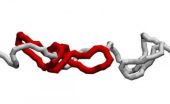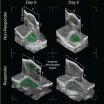(Press-News.org) Both AMD, which affects around 50 million people worldwide, and aHUS, a rare kidney disease that affects children, are associated with incorrectly controlled immune systems. A protein called complement factor H (CFH) is responsible for regulating part of our immune system called the complement cascade. Genetic alterations in CFH have been shown to increase a person's risk of developing either AMD or aHUS, but rarely both. Why this is the case has never been explained until now.
Researchers from the Wellcome Trust Centre for Cell Matrix Research and the Ophthalmology and Vision Research Group in The University of Manchester's Institute of Human Development have been expanding on their previous work that demonstrated a single common genetic alteration in CFH prevents it from fully protecting the back of the human eye. The research teams of Professor Tony Day and Professor Paul Bishop found that a common genetically altered form of CFH associated with AMD couldn't bind properly to a layer under the retina called Bruch's membrane. Having a reduced amount of CFH in this part of the eye leads to low-level inflammation and tissue damage, eventually resulting in AMD.
However, this mutation that changes CFH function in the eye has no affect on the protein's ability to regulate the immune system in the kidney. A cluster of genetic mutations in a completely different part of CFH are associated with the kidney disease aHUS, but these have no affect on the eyes.
In their most recent study, which was funded by the Medical Research Council and published in the Journal of Immunology, the Manchester researchers have identified why these mutations in CFH result in diseases in very specific tissues. Professor Day explains: "For the first time we've been able to identify why these protein mutations are so tissue specific. We're hoping our discovery will open the door to the development of tissue specific treatments to help the millions of people diagnosed with AMD every year."
The research team looked at the two parts of CFH affected by the mutations. Both regions are capable of recognising host tissues, through interacting with sugars called glycosaminoglycans (GAGs). Successfully recognising these GAGs lets CFH build up a protective layer on the surface of our tissues that prevents our own immune system from attacking them.
It had always been believed that the region with mutations associated with aHUS was the most important for host recognition and for years people have been researching how to readdress immune dysregulation based on this belief. However, the recent discovery of a single common genetic alteration in the other part of CFH that is associated with eye disease raised the possibility that this previous opinion was not fully accurate.
The Manchester researchers compared the way the different regions of the protein interacted with eye tissue and kidney tissue. They discovered that the region of CFH that helps protect the kidney had no effect in the eye. Instead the other part of CFH, which is subject to the AMD-associated genetic alteration, was fundamentally important in protecting the eye, but this region did not contribute to the binding of CFH to kidney tissue.
Their findings show, for the first time, that the level of importance of the two regions of CFH changes depending on which tissue the protein finds itself. This specificity appears to be mediated by the presence of different populations of GAGs.
Dr Simon Clark says: "Our findings suggest that the particular structure within the eye and kidney tissue determines precisely how and where CFH will bind. It's as if the tissues have their own molecular postcodes."
He continues: "We're very pleased to be able to show why mutations in CFH are so tissue specific. This is important because if we're going to improve treatments for devastating diseases, such as AMD, we need to be able to develop tissue-specific therapies."
Professor Paul Bishop, theme lead at the Manchester Biomedical Research Centre and Consultant at the Manchester Royal Eye Hospital says: "The contribution of donor samples from Manchester Eye Bank was vital for this study. Without the tissue samples that had so generously been given for research by eye donors this research would have been impossible to do."
### END
Molecular basis identified for tissue specific immune regulation in the eye and kidney
2013-02-20
ELSE PRESS RELEASES FROM THIS DATE:
The nano-channel that disentangles knots
2013-02-20
The DNA, just like hair, has a tendency to become knotted, thus it may be useful to disentangle it.
Unfortunately, it is not possible to "actively" choose at random (or better, in one solution) the filaments with the desired features, and this is why scientists adopt "passive" solutions like, for instance, having the DNA pass through nano-pores or nano-channels.
"Channels and filaments have physical features we may exploit to selectively let a type of molecule pass through" explains Micheletti. "You can have more or less entangled filaments and featuring knots of different ...
New technology in the magnetic cooling of chips
2013-02-20
Luis Hueso, the CICnanoGUNE researcher, together with researchers from the University of Cambridge, among others, has developed a new technology in the magnetic cooling of chips based on the straining of materials. Compared with the current technologies, this advance enables the impact on the environment to be lessened. The work has been published recently in the prestigious journal Nature Materials.
Current cooling systems, be they refrigerators, freezers or air conditioning units, make use of the compression and expansion of a gas. When the gas is compressed, it changes ...
A self-healing protective coating for concrete
2013-02-20
Scientists are reporting development of what they describe as the first self-healing protective coating for cracks in concrete, the world's most widely used building material. Their study on the material — which is inexpensive and environmentally friendly — appears in the journal ACS Applied Materials & Interfaces.
Chan-Moon Chung and colleagues explain that protecting concrete roads, bridges and other structures from developing tiny cracks has been a major technological challenge. Cracks allow water, salt used for deicing and air to enter the concrete. During winter ...
New IOM report highlights PEPFAR's successes
2013-02-20
WASHINGTON -- The President's Emergency Plan for AIDS Relief (PEPFAR) has saved and improved millions of lives worldwide and offered proof that HIV/AIDS services can be effectively delivered on a large scale even in countries with high rates of disease and resource constraints, says a new congressionally mandated evaluation conducted by the Institute of Medicine.
Moving forward, PEPFAR needs to intensify efforts to help its partner countries develop the capacity to manage their own programs, sustain the gains that have been made in controlling the HIV epidemic, and improve ...
New imaging device that is flexible, flat, and transparent
2013-02-20
WASHINGTON, Feb. 20, 2013— Digital cameras, medical scanners, and other imaging technologies have advanced considerably during the past decade. Continuing this pace of innovation, an Austrian research team has developed an entirely new way of capturing images based on a flat, flexible, transparent, and potentially disposable polymer sheet. The team describes their new device and its possible applications in a paper published today in the Optical Society's (OSA) open-access journal Optics Express.
The new imager, which resembles a flexible plastic film, uses fluorescent ...
Can insurers save money by providing free diabetes-related medications and supplies?
2013-02-20
New Rochelle, NY, February 20, 2013–Reducing financial barriers to medication access—a strategy known as value-based insurance design (VBID)—can improve medication adherence and management of chronic diseases such as diabetes. The economic and patient-perceived benefits of eliminating co-payments for diabetes-related medications and supplies are described in a trend-setting study published in Population Health Management, a peer-reviewed journal from Mary Ann Liebert, Inc., publishers. The article is available free on the Population Health Management website at http://www.liebertpub.com/pop.
In ...
Ancient 'Egyptian blue' pigment points to new telecommunications, security ink technology
2013-02-20
A bright blue pigment used 5,000 years ago is giving modern scientists clues toward the development of new nanomaterials with potential uses in state-of-the-art medical imaging devices, remote controls for televisions, security inks and other technology. That's the conclusion of an article on the pigment, Egyptian blue, in the Journal of the American Chemical Society.
Tina T. Salguero and colleagues point out that Egyptian blue, regarded as humanity's first artificial pigment, was used in paintings on tombs, statues and other objects throughout the ancient Mediterranean ...
6 in 10 people worldwide lack access to flush toilets or other adequate sanitation
2013-02-20
It may be the 21st century, with all its technological marvels, but 6 out of every 10 people on Earth still do not have access to flush toilets or other adequate sanitation that protects the user and the surrounding community from harmful health effects, a new study has found. The research, published in ACS' journal Environmental Science & Technology, says the number of people without access to improved sanitation is almost double the previous estimate.
amie Bartram and colleagues explain that the current definition of "improved sanitation" focuses on separating humans ...
Trustworthy mating advice deepens bond between straight women and gay men
2013-02-20
Why do straight women and gay men form close relationships with one another? A new psychology study from The University of Texas at Austin suggests the glue that cements these unique relationships is honest, unbiased relationship advice.
The study, published online in the February issue of Evolutionary Psychology, is the first to provide empirical evidence that the emotional closeness shared by straight women and gay men is rooted in the absence of deceptive mating motivations.
"Friendships between straight women and gay men are free of hidden mating agendas," says ...
Preclinical study shows potential of new technologies to detect response to cancer therapy earlier
2013-02-20
The research was published early in the January issue of the journal Technology in Cancer Research and Treatment. The article describes experiments using ultrasonic molecular imaging (USMI) and Dynamic Contrast Enhanced-Perfusion Imaging (DCE-PI) to measure response to therapy for pancreatic cancer.
Paul Dayton, PhD, senior author says, "What we found is that using two non-invasive technologies, we can detect response to therapy earlier than by relying on tumor volume changes. Having new non-invasive, inexpensive technologies available to measure response to therapy earlier ...



